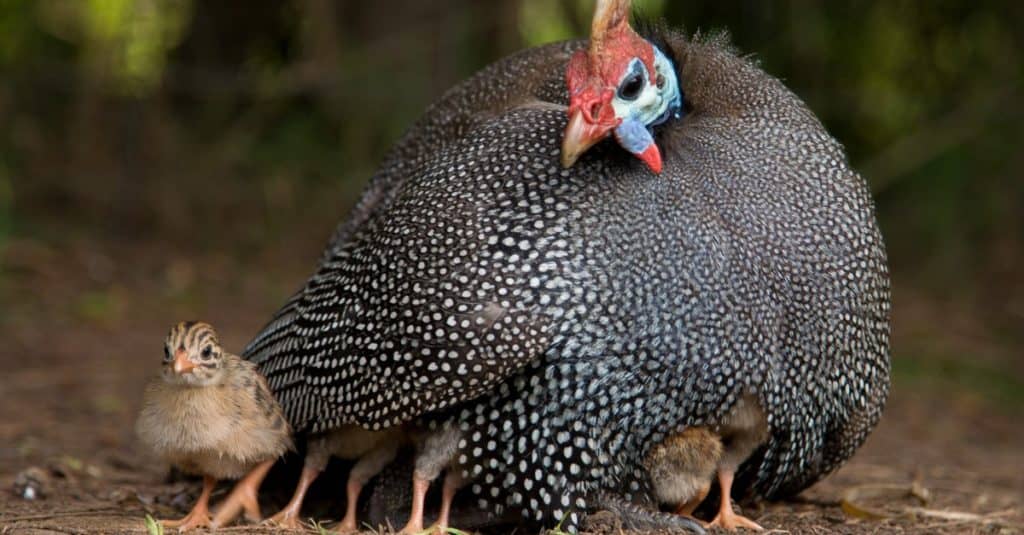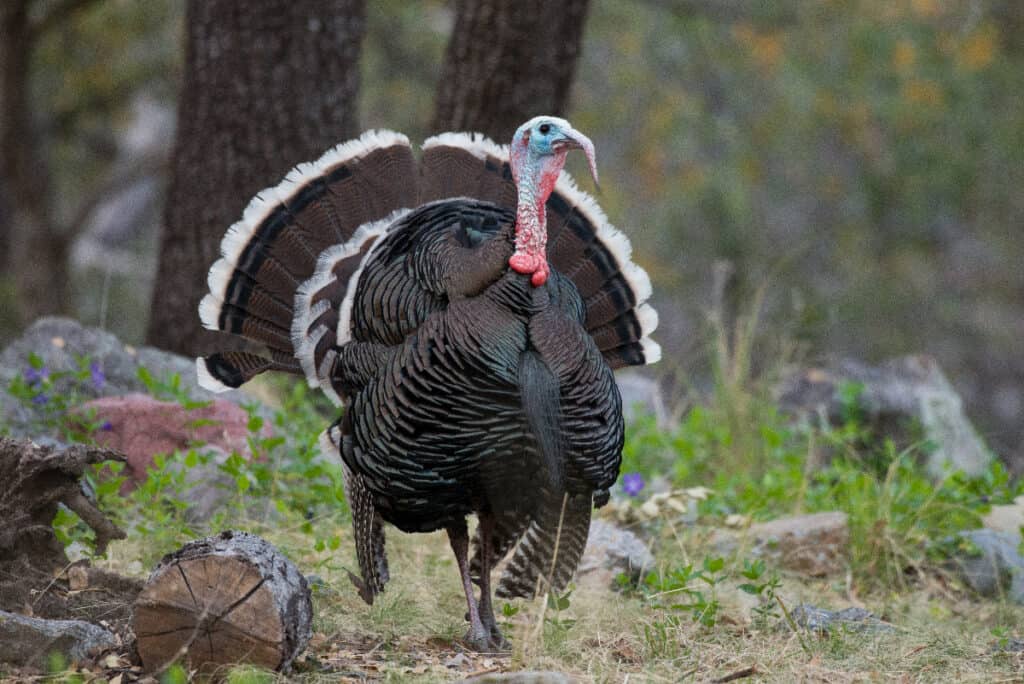Raising fowls for food or companionship is something that more people are considering these days. All you need is a plot of land, some knowledge, and some patience, and you can save yourself a trip to the store for eggs. However, not all birds that live on a farm are the same. Two of the outliers that are less popular than chickens are guinea fowls and turkeys. Take a look at a comparison between a guinea fowl vs turkey and learn about the benefits and potential drawbacks of raising and consuming these birds.
Comparing a Guinea Fowl and a Turkey

| Guinea Fowl | Turkey | |
|---|---|---|
| Size | Weight: 1. 7lbs to 3.5 lbs Height: 1.7 ft to 1.9 ft Length: 15 to 30 in | Weight: 8 to 30 lbs Height: 3 to 3.5 ft Length: 20 to 46 inches |
| Meat | – Lean, even leaner than chicken – Can be gamey – Darker meat than chickens | – Lean but protein-rich meat – Wild turkey meat is tougher and darker – Light and dark meat |
| Domestication | – Tend to range quite far – May fight amongst themselves a lot – Will harass some small predators like foxes and snakes – Often perch in high places at night | – Develop a flock and often a pecking order – May fight one another, but not as often as guinea fowls – Roost in lower areas, and sleep either outside or in a coop – May become more aggressive during the breeding season |
| Egg Size | – 1.5-2 inches in length – 1.29 inches in diameter – 1.48 oz in weight – 80-160 eggs per year – Yolk roughly the same size as that of a chicken’s – Harder, thicker shells – Brown with freckles | – 2.55 inches in length – 1.7 inches in diameter – 3.1 oz in weight – White egg, brown speckles – Thicker than a chicken egg – About 100 eggs per year |
| Location | Africa, Asia, Europe, and the Americas | North America |
| Family | Numididae | Phasianidae |
The 6 Key Differences Between a Guinea Fowl vs Turkey

Turkeys remember people, and they will approach familiar individuals.
©iStock.com/DA69
The biggest differences between a guinea fowl and a turkey include their size and egg size. The average guinea fowl weighs up to 3.5 pounds, stand 1.9 feet tall, and grows 30 inches long with eggs that are about 2 inches in length, with a production rate between 80 and 160 eggs a year at the utmost. Turkeys weigh up to 30 pounds, measure 3.5 feet tall, and measure up to 46 inches in length while having eggs over 3.5 inches long while producing about 100 each year.
These are significant differences, but they’re not the only ones. We’re going to talk about the various differences between these animals in greater depth in the following sections. The six available points of comparison will give a complete view of these animals.
Guinea Fowl vs Turkey: Size
Turkeys are much larger than guinea fowls. The average turkey weighs between 8 and 30 pounds, so even the lower end of the range is double the highest of a guinea fowl. Moreover, turkeys are taller at 3.5 feet and longer at 46 inches.
Guinea fowls weigh 3.5 pounds, stand 1.9 feet tall, and measure 30 inches in length. All told, that’s not very large compared to the famous holiday bird.
Guinea Fowl vs Turkey: Meat

Guinea fowls produce very lean meat.
©Tim_Booth/Shutterstock.com
The meat of a guinea fowl is described as leaner than chicken, easy to overcook, darker, and gamier than other fowls. The turkey has lean but protein-rich meat with plenty of light and dark meat on the bird. Still, the wild turkeys that are not raised and bred specifically for meat will have dark, tough meat that is not too appealing to some people.
Guinea Fowl vs Turkey: Domestication
Turkeys are like most other fowls in that they live in social flocks. Within these flocks, they often develop and maintain a pecking order. They may occasionally fight to determine which turkey is ranked where in that order, but the fights aren’t especially violent or frequent.
These birds prefer to roost in lower areas, and some sleep outside, and others prefer the comfort of a coop. These birds get used to the presence of people, but they can become aggressive during the breeding season.
Guinea fowls are known for being noisy, so they’re not great if you don’t have a fair amount of land to house them. They do fight amongst themselves quite a bit, especially when it comes to males harassing and chasing females.
Fortunately, these birds are willing to eat ticks and chase off other pests like snakes, so they make a good addition to flocks. They often prefer to perch somewhere high for the night, and they often prefer to be outside.
Guinea Fowl vs Turkey: Egg Size

Fowl eggs vary in size, but turkey eggs are among the largest.
© Fona/Shutterstock.com
Turkeys have larger eggs than guinea fowls. The average turkey egg is 2.55 inches in length, 1.7 inches in diameter, and 3.1 ounces in weight. They tend to be white with brown speckles, too. These eggs are even larger than chicken eggs, but high-producing turkeys only lay about 100 eggs per year. Turkey eggs are very rich and nutritious, though.
Guinea fowls produce about 80 to 160 eggs per year, but they are only about 1.5 to 2 inches in length, 1.29 inches in diameter, and 3.1 ounces in weight. Their eggs have a lot more yolk for their size compared to a chicken’s egg, though. These eggs are also thick and hard to break, and they are brown with freckles.
Guinea Fowl vs Turkey: Location
The guinea fowl is originally from sub-Saharan Africa, but it has since spread to Asia, Europe, and the Americas. Meanwhile, the turkey is originally from North America, but it has since spread around the world, too.
Guinea Fowl vs Turkey: Family
The guinea fowl resembles a turkey, but they are from the Numididae family. Turkeys are from a different family called Phasianidae. Both of these birds stem from the order Galliformes. In short, these birds are somewhat related but not so much that they are very similar.
Guinea Fowl vs Turkey: Which Makes the Better Farm Animal?

Turkeys are not as loud or aggressive as guinea fowls.
©Sean R. Stubben/Shutterstock.com
There is no doubt that turkeys have better behavior, and they provide more meat when they are processed. However, those factors don’t automatically make them better farm animals. Their eggs are relatively few compared to guinea fowls with high production.
Both birds can exhibit behavior that is difficult to deal with, especially fights between males and females. However, you should also consider the domestication element of these birds. The turkey is easily controlled and can be confined to a reasonably sized farm.
Guinea fowls are not so easily contained, and they are very noisy to boot. With that in mind, the turkey is probably a better bet for most people. However, if you want to get more eggs from your farming efforts, you may want to get chickens instead.
The photo featured at the top of this post is © tristan tan/Shutterstock.com
Thank you for reading! Have some feedback for us? Contact the AZ Animals editorial team.






